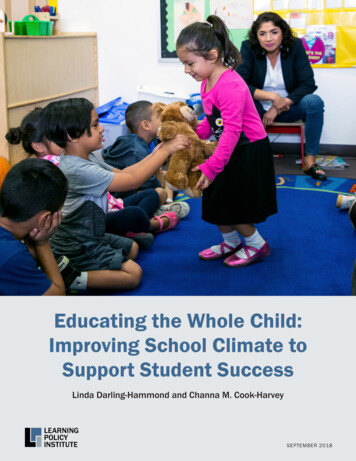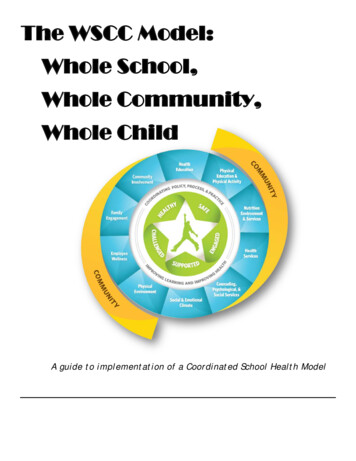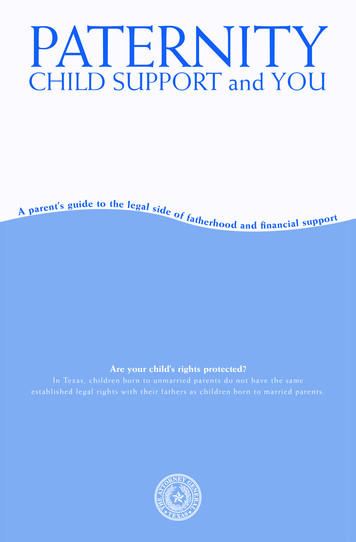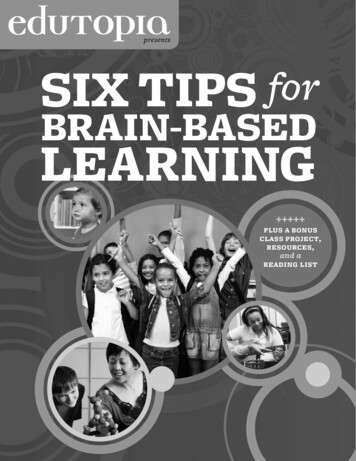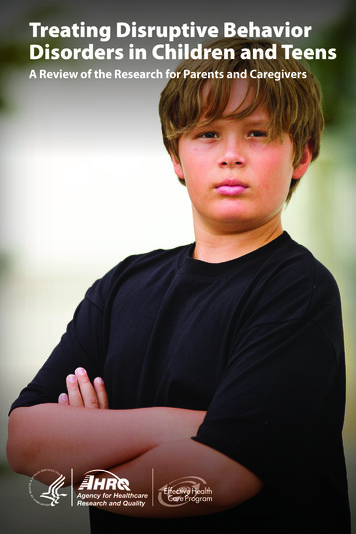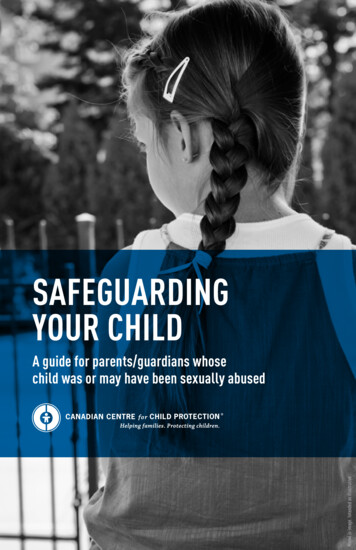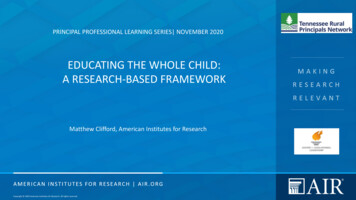
Transcription
PRINCIPAL PROFESSIONAL LEARNING SERIES NOVEMBER 2020EDUCATING THE WHOLE CHILD:A RESEARCH-BASED FRAMEWORKMatthew Clifford, American Institutes for ResearchCopyright 20XX American Institutes for Research. All rights reserved.
Changes to learning in 2020Student home and learning situations changed dramatically in 2020, and schools haveresponded with renewed focus on educating the whole child. Online learning is now the primary instructional modality. Students with disadvantages experience heightened barriers tolearning. More students are experiencing out-of-school time and gaps inlearning. Parents are concerned about food sourcing. More families are receiving federal support, due to unemploymentor underemployment.AMERICAN INSTITUTES FOR RESEARCH AIR.ORGCENTER FOR EDUCATIONAL LEADERSHIP C E L . U T K . E D U2
Educating the ‘whole child’Addressing the developmental needs of the whole child is essential now. But what does educating the“whole child” mean?HealthSafetyAAmerican Institutes for ResearchLearning Policy InstituteASCDEdCounselTurnaround for ChildrenNational Research AcademiesMind, Brain and Education at HarvardAcademicsAMERICAN INSTITUTES FOR RESEARCH AIR.ORGCENTER FOR EDUCATIONAL LEADERSHIP C E L . U T K . E D U3
Educating the whole child: Student healthSchool, working in partnership with other agencies, support student physical and mental health.Health: Each student enters school physically healthy and supported, and schools work inpartnership with families and agencies to develop students’ healthy habits and lifestyles.What’s included: Nutritional health and care Mental health and care Social supports and care (caring adults and family)What it means for schools: Strong school culture focused on student care Tight-knit and committed staff Personalized support and intervention Pre-elementary readiness Partnerships with community organizations Integrated service support and dataWhat the research says: Healthy diet and behaviorsassociated with higher academicperformance. Students with balanced dietsperform better, academically. Student exercise is associated withbetter mental health. Student exposure to trauma affectsperformance, attendance andsuccess.Sources: American Institutes for Research, 2020; ASCD, 2019; Centers for Disease Control, 2017; US Department of Agriculture, 2019; National Child Traumatic Stress Network, 2008; Science of Learning and Development, 2019AMERICAN INSTITUTES FOR RESEARCH AIR.ORGCENTER FOR EDUCATIONAL LEADERSHIP C E L . U T K . E D U4
Educating the whole child: Student healthASCD (2019) provides useful indicators for K-12 school activities supportive of student health. School culture supports and reinforces heath and well-being o f each child. Health curriculum addresses student mental, nutritional, physical, emotional,social dimensions. School schedules support and reinforce healthy life styles. School physical education program reinforces health and engagement, regardlessof fitness. School formally addresses health and well-being of staff. School has formal partnerships with parents and community provides to supportstudent health. School sets realistic goals for each students’ health and development. School food service supports healthy nutritional choices. School revisits data on student health, stress, access to food, poverty by subgroupto match needs with services.Sources: ASCD, 2019, p. 17.AMERICAN INSTITUTES FOR RESEARCH AIR.ORGCENTER FOR EDUCATIONAL LEADERSHIP C E L . U T K . E D U5
Educating the whole child: Student safetySchool, working in partnership with other agencies, support student physical and mental health.Safety: Each student learns in an environment that is physically, emotionally safe for studentsand staff.What the research says:What’s included: Student that have experienced trauma Physical safety and freedom from threatsface attention, engagement, and Emotional safety and freedom from threatsadvancement challenges. Supportive social network Explicit modeling of social-emotionalcompetencies creates safeWhat it means for schools:environments for learning. School security plans Strong, supportive school climate is Equitable disciplinary policiesassociated with reduced anti-social Establishing welcoming environmentbehavior and bullying. Social and emotional development and education Proactive and non-punitive disciplinaryAcademics Character educationpolicies are associated with more Restorative justice initiativespositive student behaviors. Partnerships for school safety Trauma informed education Counseling servicesSources: Klinger and Klinger, 2019; NCES, 2017; Gallup, 2017; Osher et al., 2010; Thapa, 2017; National Commission for Social, Emotional and Academic Learning, 2018AMERICAN INSTITUTES FOR RESEARCH AIR.ORGCENTER FOR EDUCATIONAL LEADERSHIP C E L . U T K . E D U6
Educating the whole child: Student safetyASCD (2019) provides useful indicators for K-12 school activities supportive of student safety Schools can ensure grounds, buildings, vehicles are secure. School grounds allow for easy traffic flow by multiple modes of transportation. Schools are welcoming to all, regardless of background, experience or currentcontext. Schools check that students and staff feel valued, recognized, supported,motivated. Schools maintain codes of conduct that are equitably enforced. School curriculum explicitly teaches self-reflection, self-regulation and socialemotional support strategies. School leaders and teachers set high expectations for all. School staff check personal and institutional biases regularly and ensure curriculaare free of bias.Sources: ASCD, 2019, p. 17.AMERICAN INSTITUTES FOR RESEARCH AIR.ORGCENTER FOR EDUCATIONAL LEADERSHIP C E L . U T K . E D U7
Educating the whole child: Student academicsSchool, working in partnership with other agencies, support student physical and mental health.Academics: Curriculum and instruction are the core of what schools do.AWhat’s included: Student engagement Student proactive and responsive support Cognitively-challenging, personalized learningWhat this means for schools: Equitable access to talented educators Availability of well-rounded academic program Focus on individual student development Setting high expectations for all Understanding learning processes Establishing learning contextsWhat the research says: Each student has potential to learn andthrive. Each student learns and developsdifferently. Learning is non-linear. Social, cultural and historical contextsinfluence academic learning. Learning is an integrative process. Learning that requires performance inauthentic ways that are valued by studentsand adult is more engaging.Sources: Aspen Institute, 2018; National Academies Press, 2004; 2018; National Commission for Social, Emotional and Academic Learning, 2018; Newmann and Associates, 2009; Science of Learning and Development, 2019AMERICAN INSTITUTES FOR RESEARCH AIR.ORGCENTER FOR EDUCATIONAL LEADERSHIP C E L . U T K . E D U8
Matthew Clifford, principal investigatorwww.air.orgmclifford@air.orgCopyright 20XX American Institutes for Research. All rights reserved.
ResourcesAmerican School Counselor Association. (2016). Student-toschool-counselor ratio 2015–2016. Retrieved from me/Ratios15-16.pdfASCD (2019). The Whole Child Network. New York: Author.ASCD (2007). The learning compact redefined: A call to action. Retrieved %20 Learning%20Compact.pdfThe Aspen Institute National Commission for Social, Emotional, and Academic Learning. (2018). From a nation at riskto a nation at hope: Recommendations from the national commission on social, emotional, and academicdevelopment. Retrieved from http://nationathope.org/ wp-content/uploads/2018 aspen finalreport full webversion.pdfBattelle for Kids. (n.d.). Partnership for 21st Century Learning. A Network of Battelle for Kids. Retrieved fromhttp://www.battelleforkids.org/ networks/p21Bransford, J. D., Brown, A. L., & Cocking, R. R. (2000). How people learn (Vol. 11). Washington, DC: National academypress.AMERICAN INSTITUTES FOR RESEARCH AIR.ORGCENTER FOR EDUCATIONAL LEADERSHIP C E L . U T K . E D U10
ResourcesCenters for Disease Control. (2017). Youth risk behavior surveillance system (YRBSS) overview. Retrieved fromhttps://www.cdc.gov/ healthyyouth/data/yrbs/overview.htmCivic Enterprises and Everyone Graduates Center at the School of Education at John Hopkins University. (2018).Building a grad nation: Progress and challenges in raising high school graduation rates. Retrieved fromhttps://www.americaspromise.org/ Child Trends. (2016). Food insecurity. Retrieved from rityCornelius-White, J. (2007, March). Learner-centered teacher-student relationships are effective: A meta-analysis.Review of educational research, 77(1), 113–143.Wit, D. J. D., Karioja, K., Rye, B. J., & Shain, M. (2011). Perceptions of declining classmate and teacher supportfollowing the transition to high school: Potential correlates of increasing student mental health difficulties. Psychologyin the Schools, 48(6), 556–572.Fronius, T., Persson, H., Guckenburg, S., Hurley, N., & Petrosino, A. (2016). Restorative justice in U.S. schools: Aresearch review. San Francisco: WestEd. Retrieved from http://www.antoniocasella.eu/ restorative/Fronius feb16.pdfAMERICAN INSTITUTES FOR RESEARCH AIR.ORGCENTER FOR EDUCATIONAL LEADERSHIP C E L . U T K . E D U11
ResourcesHargreaves, A., & O’Connor, M. (2018). Collaborative professionalism: When teaching together means learning for all.Victoria, Australia: Centre for Strategic Education.Hargreaves, A., & Shirley, D. (2008). Leading from the middle: Spreading learning, well-being, and identity acrossOntario. Ontario, Canada: Council on Ontario Directors of Education Report.Koltko-Rivera, M. E. (2006). Rediscovering the later version of Maslow’s Hierarchy of Needs: Self-transcendence andopportunities for theory, research, and unification. Review of general psychology, 10(4), 302–317.Jones, J. M. (Ed.). (2017, August 17). Parental fear about school safety back to pre-Newtown level. Retrieved fromhttp://news.gallup.com/ ewtown-level. aspxKlinger, A., & Klinger, A. (2018). Keeping students safe every day: How to prepare for and respond to school violence,natural disasters, and other hazards. Alexandria, VA: ASCD.Kutsyuruba, B., Klinger, D. A., & Hussain, A. (2015, June). Relationships among school climate, school safety, andstudent achievement and well being: A review of the literature. Review of Education, 3(2), 103–135.AMERICAN INSTITUTES FOR RESEARCH AIR.ORGCENTER FOR EDUCATIONAL LEADERSHIP C E L . U T K . E D U12
Resources for principals: CASEL curates educator resources (www.casel.org)National Academies of Sciences, Engineering, and Medicine. (2018). How people learn II: Learners, contexts, andcultures. National Academies Press.The National Center for Education Statistics. (2015). Retrieved dicator rbb.aspThe National Center for Education Statistics. (2016). Retrieved fromhttps://nces.ed.gov/programs/coe/indicator cgf.aspThe National Center for Education Statistics. (2017). Student reports of bullying: Results from the 2015 school crimesupplement to the national crime victimization survey. Retrieved from https://nces. ed.gov/pubs2017/2017015.pdfThe National Child Traumatic Stress Network. (2008). Child trauma toolkit for educators. Retrieved fromhttps://www.nctsn.org/ resources/child-trauma-toolkit-educatorsThe National Commission on Excellence in Education. (1983, April). A nation at risk: The imperative for educationalreform. Retrieved from 2/A Nation At Risk 1983.pdfNational Research Council, Donovan, S., & Bransford, J. (2005). How students learn. National Academies Press.AMERICAN INSTITUTES FOR RESEARCH AIR.ORGCENTER FOR EDUCATIONAL LEADERSHIP C E L . U T K . E D U13
Resources for principals: CASEL curates educator resources (www.casel.org)Osher, D., Bear, G. G., Sprague, J. R., & Doyle, W. (2010, February). How can we improve school discipline?Educational Researcher, 39(1), 48–58.Putnam, R. D. (2015). Our kids: The American dream in crisis. New York: Simon and Schuster.Quaglia, R. (In press). The power of voice: Listen, learn, lead. Alexandria, VA: ASCD.Roorda, D. L., Koomen, H. M., Spilt, J. L., & Oort, F. J. (2011, December). The influence of affective teacher–studentrelationships on students’ school engagement and achievement: A meta-analytic approach. Review of EducationalResearch, 81(4), 493–529.Science of Learning and Development Alliance (2019). How the science of learning and development can transformeducation. New York: Author.Tichnor-Wagner, A., & Manise, J. (2019). Globally competent educational leadership: A framework for leading schoolsin a diverse, interconnected world. Retrieved from http://files.ascd.org/pdfs/ ionalleadership-report-2019.pdfUnited States Department of Agriculture. (2017). Food access research atlas. Retrieved fromhttps://www.ers.usda.gov/data-products/ food-access-research-atlas/AME R I C A NM.I N ST.,T I T&U TDegol,E S F O R J.R E(2014,S E A R C H September). AIR.ORGWang,CENTER FOR needsEDUCATIONALLEADERSHIP CEL.UTK.EDUStaying engaged: Knowledge and researchin studentengagement.14
Resources for principals: CASEL curates educator resources (www.casel.org)Wang, M. T., & Degol, J. (2014, September). Staying engaged: Knowledge and research needs in student engagement.Child Development Perspectives, 8(3), 137–143.Wang, M. T., & Degol, J. L. (2016, June). School climate: A review of the construct, measurement, and impact onstudent outcomes. Educational Psychology Review, 28(2), 315–352.AMERICAN INSTITUTES FOR RESEARCH AIR.ORGCENTER FOR EDUCATIONAL LEADERSHIP C E L . U T K . E D U15
School culture supports and reinforces heath and well-being o f each child. Healthcurriculum addresses student men

